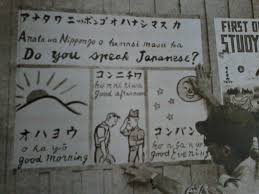 |
| St John Brigade students marching in a school in Singapore, 2016 |
Being a British colony, the average Singaporean was either educated in English or any of the local dialects. With the Japanese take over, the programme of decolonisation began. The first schools were reopened in 12 April 1942, and the Japanese kicked off their education agenda. Education would be as a tool to unite Singaporeans under the banner of the Greater East Asia Co-Prosperity Sphere with the idea of Hakko Ichiu (universal brotherhood). In other words, it became propaganda.
All locals were pressured into learning Japanese. All textbooks were converted to Japanese, and the teachers had to teach in that language. Students had to sing the Japanese anthem (kimigayo), while facing the Northeast -- the direction of their new masters, Imperial Japan. Students had to learn Japanese customs (like exercising every morning and bowing to all Imperial soldiers). The British curriculum of teaching academic subjects was swiftly replaced the Japanese system of character development and vocational skills. To attract students to this new system, rations (like milk and rice) were given to those in attendance.
People who picked up Japanese quickly were rewarded with higher education (and hence better jobs), or material gains from the Japanese masters. Those who continued the old ways either by possession of contraband material (like English textbooks or radios) or refusal to learn Japanese customs were punished, sometimes lethally.
The message was clear. The Japanese were here to stay; and therefore the destiny of the Singapore was no longer in the hands of the British or the locals. Mandarin, English and Dutch were banned in Singapore, while Indian schools were allowed to flourish (to support the Indian Independence movement against the British).
Japanese would become the lingua franca of Occupied Singapore.
For more details:

Comments